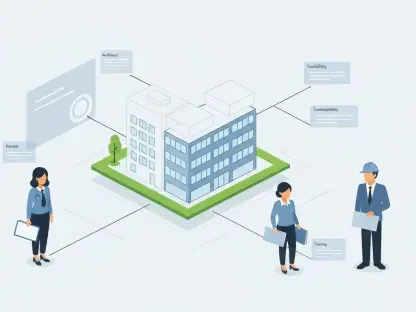As Oregon’s construction industry braces for upcoming changes in legal responsibilities, Senate Bill 426 emerges as a significant legislative milestone, reshaping the obligations and liabilities borne by property owners and contractors alike. Set to become enforceable on January 1, 2026, this law reframes how financial accountability is assigned throughout construction projects, particularly emphasizing the protection of employee wages and benefits. The enactment of SB 426 not only signifies a notable shift in Oregon’s construction and employment law but also marks a changing landscape where property owners and contractors must place heightened focus on worker compensation issues upstream in the contracting hierarchy.
Understanding the Deepening Liability Framework
Property Owners’ Expanding Obligations
Property owners in Oregon are now required to ensure subcontractor employees are paid accurately, as SB 426 broadens who is considered liable for unpaid wages. This responsibility applies even in cases where the owner has no direct managerial oversight over the workers’ activities or wage distributions. Therefore, property owners must exercise due diligence in hiring practices and contractual agreements to avoid inadvertently absorbing financial liabilities associated with subcontractor misconduct. The broad definition of what constitutes an “owner,” as outlined in the bill, means many individuals and entities may be covered, extending to those with mere ownership interests.
For owners, one of the distinct features is an exemption for residential projects limited to five units or less, which introduces a modicum of relief amid these comprehensive requirements. Furthermore, certain entities, like public agencies or those acquiring property through foreclosure, are also exempted. However, this underscores how the legislation primarily targets commercial property owners heavily involved in the construction market, ensuring workers’ rights are better safeguarded without exceptions based on ownership type or intention.
Direct Contractors Face New Challenges
Direct contractors, akin to property owners, must now grapple with increased legal responsibilities. One of the primary challenges is the law’s requirement that they ensure subcontractor employees are properly compensated, encompassing both wages and fringe benefits, similar to the property owners’ responsibilities. The liability falls on contractors unless they can legally prove otherwise, reversing the traditional set of responsibilities which were largely relegated to direct employers or subcontractors. This creates a chain of accountability significantly influencing project management strategies and the selection of subcontractors moving forward.
Interestingly, SB 426 also introduces new protective measures for employees not affiliated with labor organizations or represented under collective bargaining agreements. The institution of the “rebuttable presumption” clarifies that workers are assumed to be employees rather than independent contractors. Consequently, direct contractors must be prepared to prove these classifications if challenged, increasing the administrative burden but ultimately aiming to protect more workers’ rights consistently across projects in Oregon’s construction industry landscape.
Navigating the Legal Terrain of SB 426
Enhancements in Wage Recovery Solutions
Oregon’s Senate Bill 426 strengthens the pathways available to workers seeking unpaid wages by widening the scope of accountability, thus offering new remedies. Employees can now pursue wage recovery not only from their immediate employer but also from property owners and contractors who may have indirectly benefited from their labor. This expansion of recourse is pivotal in addressing wage theft and ensuring laborers’ rights are maintained, especially within the complex layers of the contracting chains in construction projects.
For affected employees, this means an amplified chance of recuperating due wages even if their direct employer is unable or unwilling to pay. Legal avenues previously unavailable are now open, offering an essential safety net. However, this also potentially translates into increased legal costs and processes as claims can be pursued against entities further up the contracting chain. Owners and contractors must be adequately prepared for increased scrutiny over payment practices within their projects, necessitating effective communication and documentation throughout the subcontracting process.
Compliance and Mitigation Strategies for Contractors
To navigate the new legal landscape, property owners and contractors should prioritize crafting meticulous contractual agreements that anticipate possible wage-related disputes. The law allows a structured complaint process where owners and contractors receive a 21-day rectification period following notice of alleged violations. This proactive window acts as a safeguard, offering a chance to address compliance issues without immediately resorting to litigation. This nuance is designed to minimize the disruption of potential disputes through quick, straightforward resolutions, which are beneficial to all parties involved.
Additionally, SB 426 reinforces the necessity for keeping comprehensive payroll records and emphasizes transparency. Contractors are expected to request and maintain certified payroll documentation, detailed worker contact records, and other related documentation from subcontractors to ensure compliance. Maintaining this data helps comply with SB 426’s requirements while also facilitating quick issue resolution. These layers of documentation are not mere formalities but practical tools enabling property owners and contractors to demonstrate compliance and effectively manage liability.
Long-term Industry Implications and Future Considerations
Navigating Risks and Strategic Planning
As the construction industry anticipates the changes initiated by SB 426, strategic adjustments in risk management and operational practices become crucial. Owners and contractors may need to recalibrate their approaches, focusing on ensuring that subcontractors comply with wage laws and that all projects have the necessary oversight mechanisms. The industry must move towards a culture of stringent compliance, realigning strategies to incorporate robust checks on subcontractor activities and reinforce worker rights in even the most intricate project, thereby minimizing financial and reputational risks.
Contractual safeguards and operational changes may provide some alleviation, yet these reforms may require investment in compliance training and adaptation. While SB 426 stipulates that owners and contractors cannot absolve liability through contractual terms, establishing clear agreements with subcontractors regarding expectations and responsibilities could help manage risk proactively. Understanding the nuances of these new obligations will enable industry players to adapt and maintain compliance in this dynamically evolving legal environment.
Progressing Towards Equitable Wage Practices
As Oregon’s construction industry prepares for new legal changes, Senate Bill 426 represents a major legislative development, altering the responsibilities and liabilities of property owners and contractors alike. This bill, effective January 1, 2026, redefines how financial responsibility is assigned in construction projects, particularly focusing on safeguarding employee wages and benefits. SB 426’s implementation signifies more than just a shift in Oregon’s construction and employment laws; it heralds a move toward greater emphasis on worker compensation issues, requiring property owners and contractors to pay more attention to fair labor treatment and financial transparency higher up in the contracting chain. This law aims to foster a more equitable and transparent environment within the construction industry, ensuring that workers are fairly compensated and that liability for wages is more clearly defined. As such, businesses involved in construction will need to adapt to these new legal duties, emphasizing compliance to navigate this changing landscape successfully.









